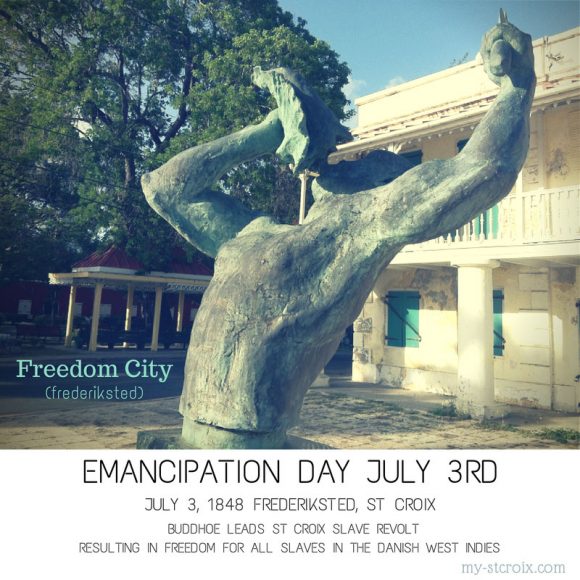
While many across the United States and its Territories observe the 4th of July holiday celebrating American Independence, July 3rd marks a very important holiday here in the US Virgin Islands – Emancipation Day.
One of my favorite books is Island Beneath the Sea by Isabel Allende which tells the harrowing saga of Zarité from her slavery on a sugar plantation in Saint-Domingue through her escape and participation in the uprising and successful slave revolt in Haiti to her eventual arrival in New Orleans. Though it’s historical fiction it offers insight into a dark time and the struggles and strength associated with survival amidst such brutality.
Here on St Croix, there’s a very similar and equally heroic story.
History of Emancipation in the US Virgin Islands
70 years after the revolutionists in the thirteen colonies rose up from tyranny in 1776 and 17 years before chattel slavery was fully abolished in the United States*, the enslaved on St Croix banded together and coordinated an uprising. They were the second island in the Caribbean after Haiti to demand their freedom and set the precedent for emancipation throughout the Caribbean. It is often said that Danish Governor Peter von Scholten abolished chattel slavery. And while it is technically true, it was actually an uprising of heroic enslaved people on July 3, 1848, that prompted him to do it much earlier than he had planned.
Appointed Governor-General in 1827 by King Frederick of Denmark, von Scholten was an advocate of the gradual emancipation of the enslaved people. Undoubtedly, his mistress and confidante, “free-coloured” Anna Heegaard, had an influence on his philosophies. The trans-Atlantic slave trade had ceased in 1803. But, the brutality of forced chattel slave labor on the sugar plantations continued on St Croix and throughout the Caribbean.
In 1839, von Scholten began building schools to educate enslaved children. In 1847 Governor von Scholten proposed his 12-year plan to emancipate the enslaved. A plan that was quite unpopular with local plantation owners.

General Buddhoe
John Gottlieb (General Buddhoe) a skilled, freed slave was not about to wait 12 years. Buddhoe, along with his Admiral Martin King, organized the enslaved workers on the West End of St Croix. They coordinated a gathering in Frederiksted at the blowing of the conch shell on the morning of July 3, 1848. Following the call, a large group of enslaved and free coloreds stormed and took Fort Frederik. The crowd demanded that by noon the enslaved be declared free or they would burn down the town.
They sent the ultimatum to Governor von Scholten in Christiansted. Some hypothesize that von Scholten and Buddhoe may have had a previous clandestine agreement. Other stories have it that von Scholten was en route to the slave school at Mount Victory just outside of Frederiksted to oversee an exam when he received the word and was diverted.
Either way, the deadline was extended slightly, and by 3 pm von Scholten declared the enslaved to be free. Knowing the history of the Haitian rebellion, they avoided what undoubtedly could have been a very bloody battle with many casualties.

Emancipation Day in the Virgin Islands: Epilogue
Freedom for the enslaved didn’t mean true emancipation. Many of them still toiled in unfair conditions earning meager wages that kept them impoverished. In October 1878, labor organizers rebelled again … led by three rebel Queens for the “fyah burn” but that’s another story for another time.
St Croix and many other influential Crucians have had a significant impact on the United States and its history. West Indian-born Alexander Hamilton spent his formative years working for an accountant on St Croix and it was his Crucian benefactors that paid for his education in New York. He later became Chief Staff Aide to General George Washington, the 1st US Secretary of the Treasury, and holds an esteemed place on the US $10 bill.
“The history of labor organizers and the long-term impact of our history and how it ties into US history is significant. Many of the labor organizers in the early 1900s’ in New York were Crucians. Hubert Harrison is referred to as ‘the foremost Afro-American intellect of his time’ and the ‘father of Harlem Radicalism.'” – Frandelle Gerard, Director Crucian History and Nature Tourism (CHANT)
To learn more about the incredible history of St Croix and the US Virgin Islands while on St Croix, book a walking tour or a hike with one of the many knowledgeable guides at CHANT. You can also visit Estate Whim Museum, a part of the St Croix Landmarks Society to learn more about life on a working sugar plantation.
*While the Emancipation Proclamation was signed on September 22, 1862, by President Abraham Lincoln, it wasn’t until June 19, 1865 – a full two and a half years later – that Federal troops went into Galveston, Texas to inform the enslaved people that they had been freed. We now celebrate that day as Juneteenth. Juneteenth was declared a Federal Holiday in 2021.

I seem to remember that St. John had a similar uprising but they actually jumped off the cliff. Can you share this history if you have it?
Indeed there was a revolt on St. John that began in 1733. Sadly, it was very violent and not successful. You can read more about it here: https://www.virgin-islands-history.org/en/timeline/the-slaves-rebel-on-st-john/
When was Emancipation Day declared a holiday on the Islands?
That’s a great question – one I don’t have the answer to. But will definitely try to find out!
Looking for information on the McBean’s